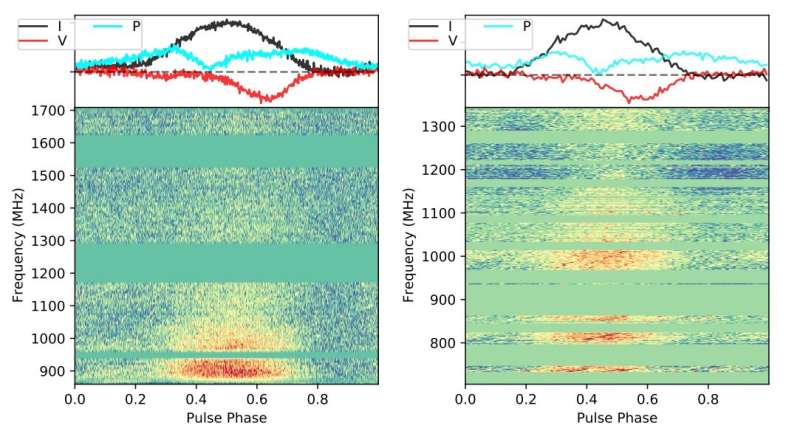May 10, 2022 report
Highly circularly polarized and variable pulsar detected in the Large Magellanic Cloud

An international team of astronomers reports the finding of a new pulsar in the Large Magellanic Cloud (LMC) as part of the Australian Square Kilometre Array Pathfinder (ASKAP) Variables and Slow Transients (VAST) survey. The newly detected pulsar, designated PSR J0523−7125, turns out to be a highly circularly polarized and variable radio source. The discovery was detailed in a paper published May 3 on arXiv.org.
Pulsars are highly magnetized, rotating neutron stars emitting a beam of electromagnetic radiation. They are usually detected in the form of short bursts of radio emission; however, some of them are also observed via optical, X-ray and gamma-ray telescopes. One method to find new pulsars is to search for them in continuum surveys and identify them through circularly polarized emission.
Using this technique, a group of astronomers led by Yuanming Wang of the University of Sydney, Australia, has recently analyzed the data from the ASKAP Phase I Pilot survey for Variables and Slow Transients (VAST-P1) searching for variable and transient sources in the two ASKAP fields covering the Magellanic Clouds. In result, they identified a highly-variable, circularly-polarized, steep-spectrum source, designated VAST J052348.6−712552. Follow-up observations of this source with the MeerKAT and Parkes telescopes confirmed that it is a pulsar located in the Large Magellanic Cloud (LMC), which received the designation PSR J0523−7125.
"We discovered a highly-variable, circularly polarized object, VAST J052348.6−712552, in a variability analysis of two fields containing the Magellanic Clouds observed as part of the VAST-P1 survey. With about 20% fractional circular polarization and no optical/infrared counterpart, VAST J052348.6−712552 was considered to be a strong pulsar candidate. Subsequent MeerKAT observations discovered a pulsar, PSR J0523−7125, associated with the continuum source, which was further confirmed with observations using the Parkes telescope," the researchers explained.
According to the study, PSR J0523−7125 has a spin period of 322.5 milliseconds. Its dispersion measure was found to be about 157.5 pc/cm3, which is consistent with the LMC origin. When it comes to the rotation measure, it was calculated to be at a level of +456 rad/m2—which is about twice the most extreme rotation measure found in LMC pulsars.
PSR J0523−7125 has an average flux density of about 1 mJy at 1,400 MHz and about 25 mJy at 400 MHz. This makes it one of the most luminous radio pulsars known to date. Moreover, PSR J0523−7125 turns out to be brighter than all known pulsars in the Magellanic Clouds at both 400 MHz and 1,400 MHz.
The astronomers underlined that despite its high luminosity, PSR J0523−7125 remained undetected in several LMC pulsar surveys. They suspect that this is largely due to its wide pulse profile or steep-spectral shape.
The researchers noted that the wide pulse profile of PSR J0523−7125 also suggests that it could be an aligned rotator. They added that the strong variability of this pulsar is likely caused by scintillation effects; however, other explanations cannot be excluded.
More information: Yuanming Wang et al, Discovery of PSR J0523-7125 as a Circularly Polarized Variable Radio Source in the Large Magellanic Cloud, The Astrophysical Journal (2022). DOI: 10.3847/1538-4357/ac61dc
Journal information: Astrophysical Journal
© 2022 Science X Network




















